Stuck staring at your sketchbook’s empty pages? Try filling them with geometric shapes, quick doodles of things around your room, or patterns from your favorite cozy blanket. Make a moodboard, draw funny mugs, sketch floral clusters, and experiment with wild color spirals or hand-lettering quotes that make you laugh. Celebrate yourself with self-portraits, and maybe even illustrate your favorite song lyrics! Mix in some art challenges, creative journaling, or zentangle designs—the ideas just keep getting better from here.
Key Takeaways
- Experiment with new mediums like charcoal, pastels, or digital tools to discover fresh visual effects and creative possibilities.
- Fill pages with self-portraits from unusual angles, using colors and textures to capture different emotions or moods.
- Doodle everyday objects from around your home, focusing on unique perspectives, groupings, or playful imaginative twists.
- Recreate and analyze artworks by favorite artists to learn their techniques and inspire your own artistic growth.
- Create and layer patterns found on household items, tiles, or fabrics, then transform them by altering colors and shapes.
Start With Geometric Shapes
Blank pages can feel like staring into a mysterious, empty cave—kind of spooky, right?
But here’s a trick: fight that fear with a squad of geometric shapes. Circles, triangles, and squares are like friendly explorers, leading the way into the unknown abyss of your sketchbook page. Grab a ruler for those ninja-straight lines if freehand’s too wild.
Once those shapes claim some territory, go wild inside them! Doodle mini shapes, wavy lines, or a galaxy of dots to turn emptiness into a pattern party.
Want extra style points? Try zentangle or mandalas—with repeating, concentric shapes—and watch your brain chill out.
Looking for inspiration? Check out artists like @mariopatterns, who rock at filling blank pages with dazzling patterns in every geometric shape.
Draw From Your Environment

There’s a whole world to sketch right in your living room, from the weird shape of your favorite mug to the epic fluffiness of your cat napping on the couch.
Even the view outside your window can turn into something wild—imagine a tree with roller skates or clouds shaped like pizza slices!
Patterns hidden in rugs, kitchen tiles, or the swirl of cereal in your bowl can lead to some seriously cool page fillers, so nothing around you is too ordinary to make awesome art.
Capture Everyday Household Objects
Who knew that a spoon, a houseplant, or even that pile of random books could become the stars of a sketchbook?
When someone feels stuck, looking around and grabbing something ordinary—a fork, a mug, a potted plant—can suddenly spark a love drawing session right at home.
Artists play with different angles, turning objects or moving themselves to see what new shapes or shadows appear. They might take notes in the margins about what caught their eye: maybe a crazy reflection on a metal spoon, or the wild pattern on a cereal box.
Sometimes, it gets lively—multiple items get grouped together in one drawing, telling a story about home life.
Sketching household stuff isn’t only fun—it’s a fresh way to see familiar things.
Window Views Reimagined Creatively
After sketching the wild patterns on cereal boxes or catching the way sunlight bounces off a metal spoon, it makes sense to look further—right out the window.
Window views are like secret comic books, always changing and full of surprises. One day there’s a weird cloud shaped like a rubber duck, the next, rain turns the road into a shiny, silver river.
To fill your sketchbook, stand in different spots, even sit on the floor if you must, and draw something unusual or ordinary that pops out. Why not make a tree wear glasses? Or add a superhero squirrel to that telephone wire?
Mixed media, like splashing watercolor over pencil lines or gluing in magazine bits, can help you express those outside moods even more.
Patterns Found at Home
Patterns are everywhere at home, just waiting to be discovered—like secret codes hidden in plain sight. Want a fresh idea for your sketchbook? Take a spin around your house!
Check out those zig-zag lines on a rug, the swirls on your favorite mug, or even the stripes on your bedsheet. Patterns can look like anything: rows of tiles, the weave of a blanket, or the leaves lining your windowsill plant. They’re all little pieces of inspiration, ready for you to draw.
Try copying a design from your curtains or flooring, then experiment—change the colors, shift the shapes, and add your twist! Draw a whole series based on one pattern, using different viewpoints.
Suddenly, your sketchbook is full of hidden surprises from home.
Journal for Self-Care
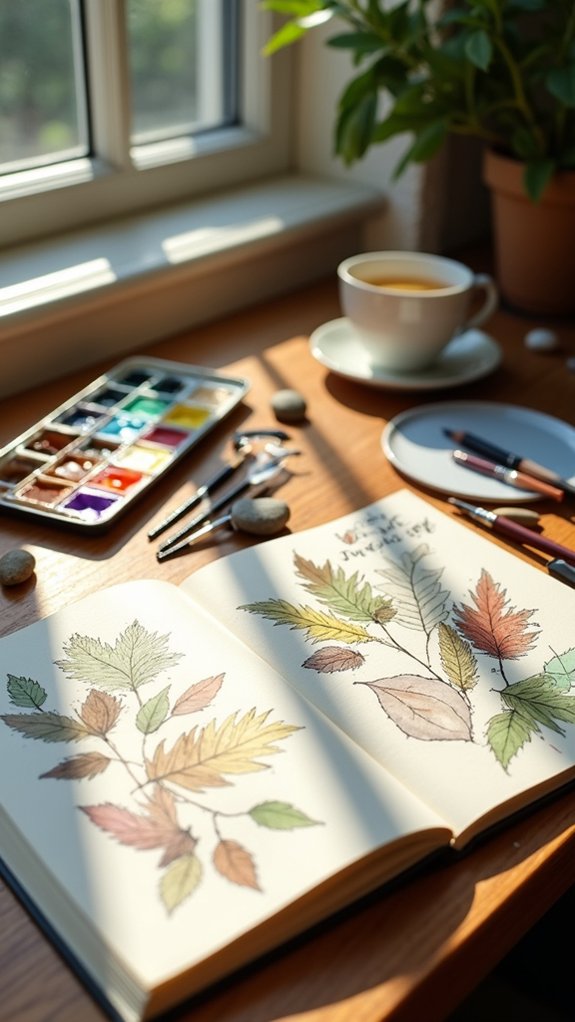
There’s just something powerful about putting your thoughts on paper, especially when life feels like a tornado of emotions. Journaling can turn that whirl into something way more manageable. Not only does writing about emotions help with self-care, but it’s also proven to lower stress and anxiety. People can dig deep into their minds, track moods, and even create gratitude lists to sprinkle some positivity on rough days. Prompts are handy if the blank page stares back menacingly—think “What’s one thing I did well today?” or “How am I feeling right now?” Reflecting like this brings clarity and calm, plus it’s a safe place for every weird, wonderful, and wild thought.
| Self-Care Habit | How It Helps |
|---|---|
| Gratitude Lists | Boosts positivity |
| Mood Tracking | Spots patterns |
| Writing Prompts | Sparks reflection |
Fill a Page With Patterns
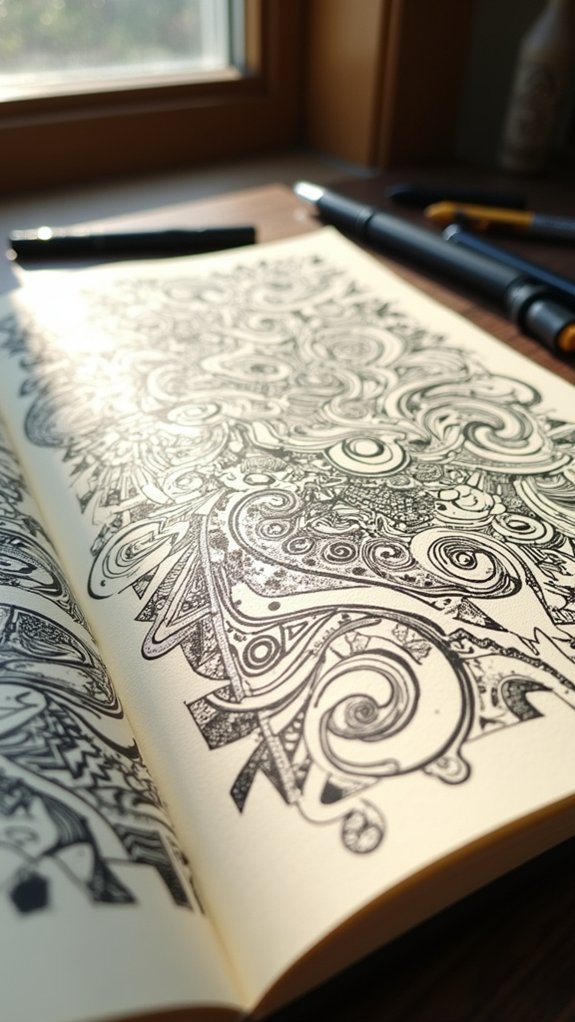
A blank sketchbook page can look just like an open invitation to go wild with patterns—seriously, it’s almost begging for zigzags, dots, swirls, and all sorts of repeating shapes.
Patterns aren’t just fun to draw; they boost creativity and help artists experiment with different kinds of composition. One moment someone might be filling the page with neat little grids or wild organic lines, the next they’re layering colors for extra punch.
Trying out markers, colored pencils, or even watercolors can make each pattern pop with depth and variety. Nature, wallpaper, or even a sock drawer can serve as pattern inspiration, sparking the imagination and nudging artists past creative blocks.
Pattern-making is less about perfection and more about letting creativity flow with surprising results.
Create a Personal Moodboard
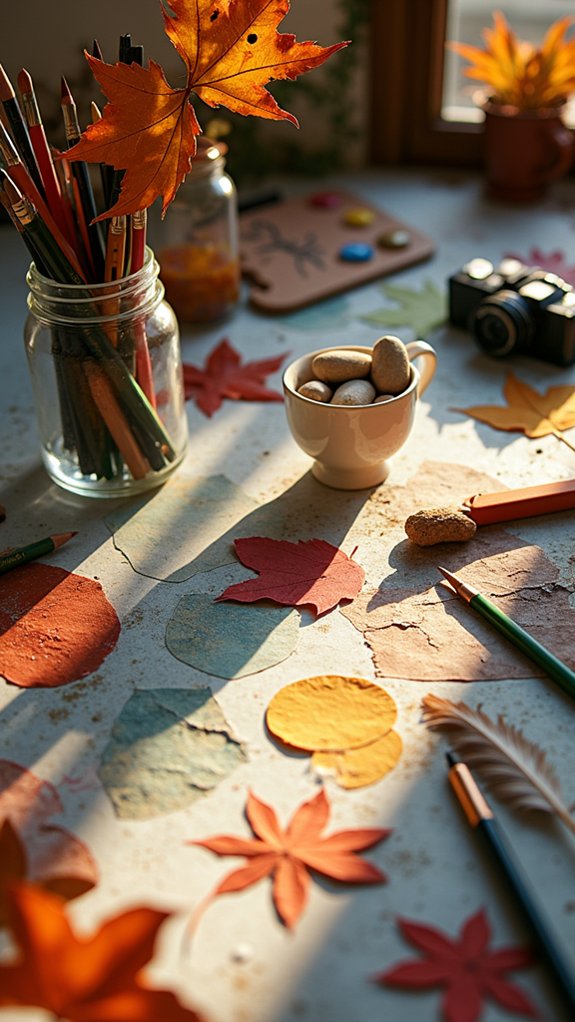
Building a personal moodboard is like gathering all your favorite sparks of inspiration in one place, from bold color swatches to magazine cutouts and funky textures.
This is where creative aesthetics come to life, giving your future sketches their own vibe and style. Whether it’s wild patterns or soothing pastels, picking out these visual treasures makes it way easier to figure out what you actually want your art to say—plus, it’s way more fun than just staring at a blank page!
Gathering Visual Inspirations
When the urge to draw hits but nothing interesting comes to mind, a personal moodboard can seriously save the day—it’s like having a treasure chest packed with colors, patterns, and ideas waiting to jump out.
By gathering visual inspirations from everywhere—magazines, online images, even your own photos—you start building a stash of creative fuel for your next sketchbook burst.
Want to keep that creative process feeling fresh and exciting? Here’s what really brings the magic:
- Mix things up: Add fabric swatches, color palettes, and quotes for a splash of personality.
- Keep it organized: Layout your moodboard so it’s easy to peek at and get inspired every time.
- Stay curious: Keep swapping out old images for new ones to keep your ideas blooming.
Defining Creative Aesthetics
Nobody wants their creativity to feel boring or just like everyone else’s—so that’s where creating a personal moodboard comes in handy!
Imagine collecting all your favorite images, colors, and random scraps that just “feel right” to you. Bringing them together on one page helps you define your personal aesthetic, kind of like an artistic fingerprint.
Moodboards aren’t just pretty collages, though—they’re fuel for your inspiration engine. Grab stuff from magazines, art books, or even your own photos, and watch how the mix gives you new ideas.
Need a color palette? Look to your moodboard! Need a style boost? Yep, moodboard again.
Freshening it up regularly keeps things relevant and exciting. It’s like a creative recharge station anytime you feel stuck.
Experiment With Collages and Mixed Media
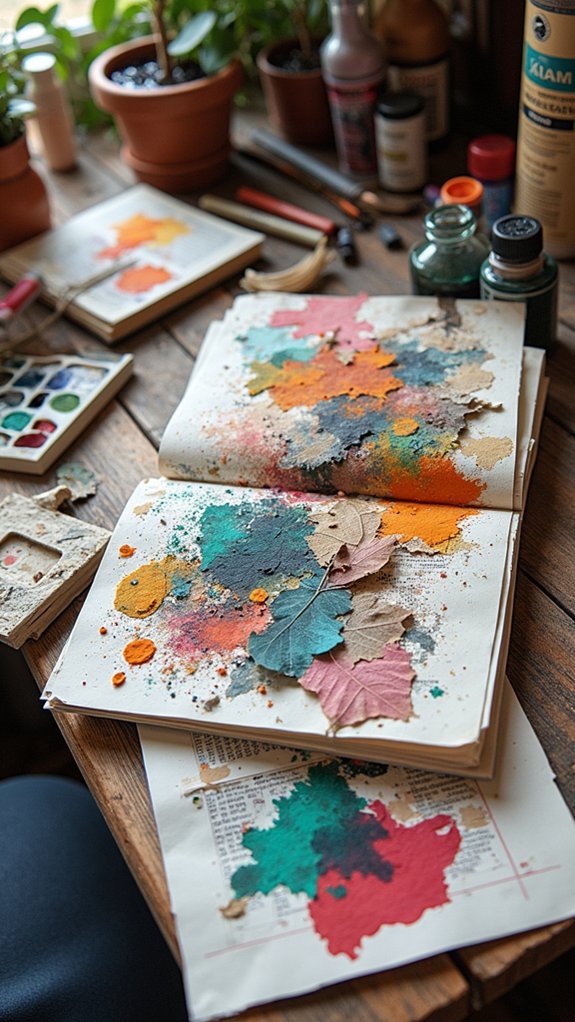
There’s something totally exciting about ripping, gluing, and layering all sorts of random stuff into a sketchbook—collages and mixed media are like a creative playground with zero rules.
If you’re ever stuck, just grab some old magazines, ticket stubs, or even leaves from outside and let the experimentation begin! Mixing ink, watercolor, and acrylics creates wild textures and surprising effects.
Using thick paper really helps, especially when you start gluing on heavier things, like pebbles or stickers. Try layering paint over your collage, or drawing right on top of photos—there are endless ways to allow your imagination run wild.
It might get messy, but that’s half the fun.
- Release wild creativity
- Transform random bits into art
- Discover new, joyful surprises
Explore Your Personal Style
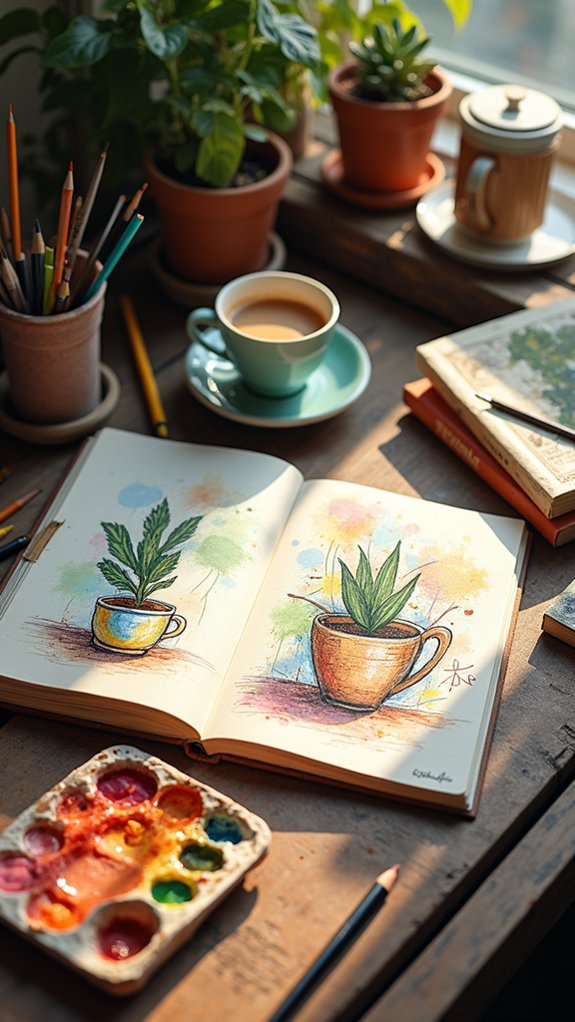
Every artist, no matter how new or experienced, has a personal style just waiting to burst out—kind of like a weird superpower that only gets stronger with practice.
Finding yours is all about trying out different artistic elements in your sketchbook. Maybe you’re obsessed with wavy lines, wild colors, or cartoon cats with mustaches—anything goes!
Drawing your favorite things from a bunch of angles or grouping similar objects, like different kinds of sneakers or leaves, can seriously help your style stand out.
Experiment with patterns, color combos, and funky character designs until something feels right.
Take time to flip back through your sketchbook, too. Notice what you love about your old sketches—sometimes the weirdest doodle leads you closer to your unique personal style.
Use Bullet Journal Prompts
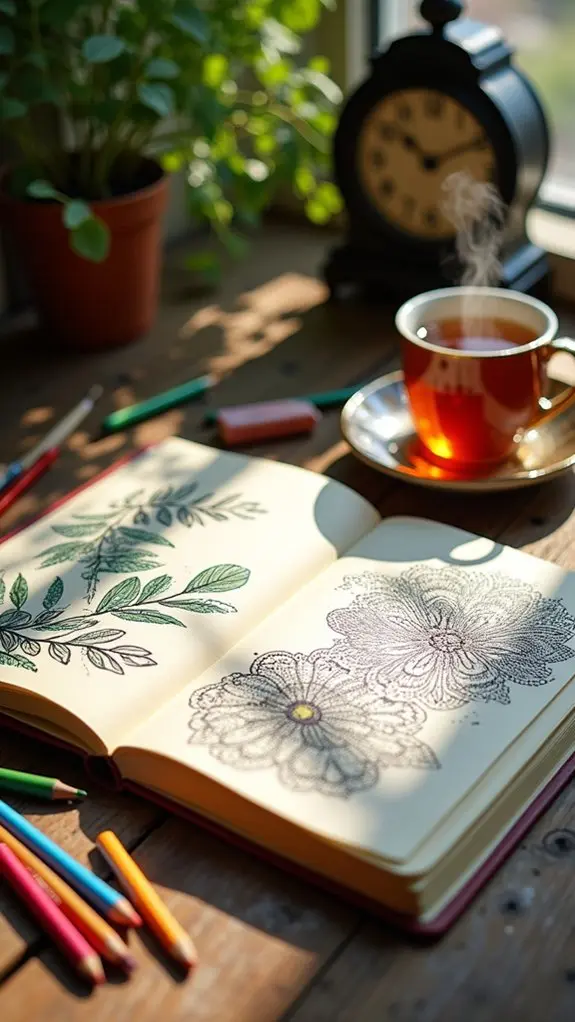
Even if someone’s sketchbook is already bursting with wild doodles and half-baked ideas, adding bullet journal prompts can crank things up to a whole new level.
Imagine flipping through your pages, finding not just art, but daily gratitude lists, mood reflections, or cool habit trackers. Suddenly, your sketchbook isn’t just for drawing—it’s a playground for your mind and emotions.
The bullet journal world is packed with creative layouts to spark inspiration, especially if you check out hashtags like #theartofbujo.
Here are three reasons bullet journal prompts can make anyone’s sketchbook feel like pure magic:
- They boost your mood and help organize your thoughts.
- You get to experiment with fresh creative layouts every day.
- They inspire personal growth while keeping things colorful and fun!
Sketchnote a Favorite Video
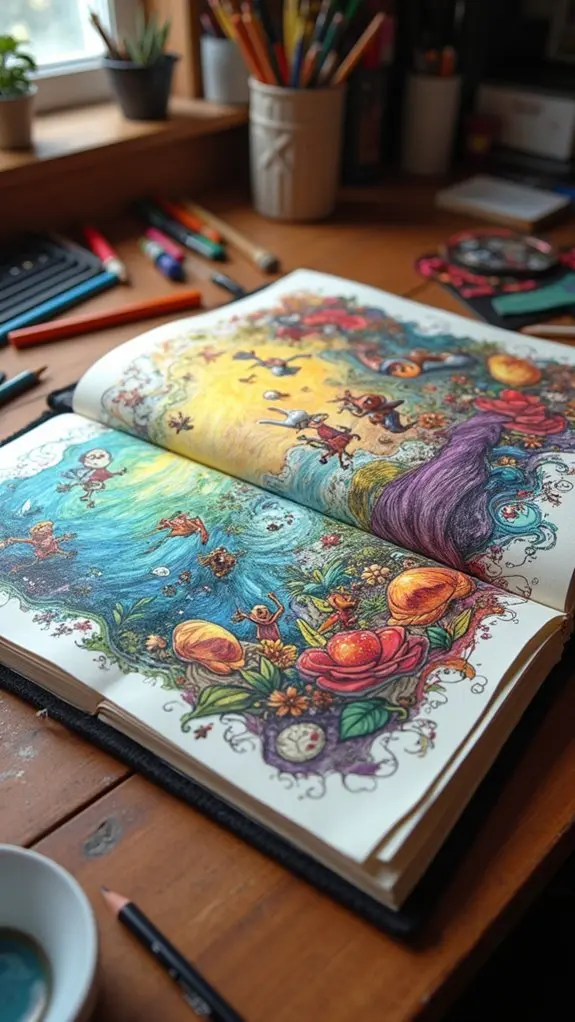
Sometimes a single video can spark a whirlwind of ideas, but trying to remember all the cool stuff crammed into it? That’s a struggle!
Sketchnoting a favorite video is like making a comic strip of everything you learn—using visuals and words mixed together. Pick a video you actually love, then listen closely, quickly sketching doodles, symbols, and super-short notes that capture the big ideas.
Practice using different colors or wacky letter styles to make important stuff pop on the page. Shapes and arrows can help connect scenes and ideas, making your sketchnote way more fun (and less boring to look at later).
When you’re done, flip through it—see what you remember. Maybe even post your masterpiece online and wow your friends!
Fashion Design Sketches
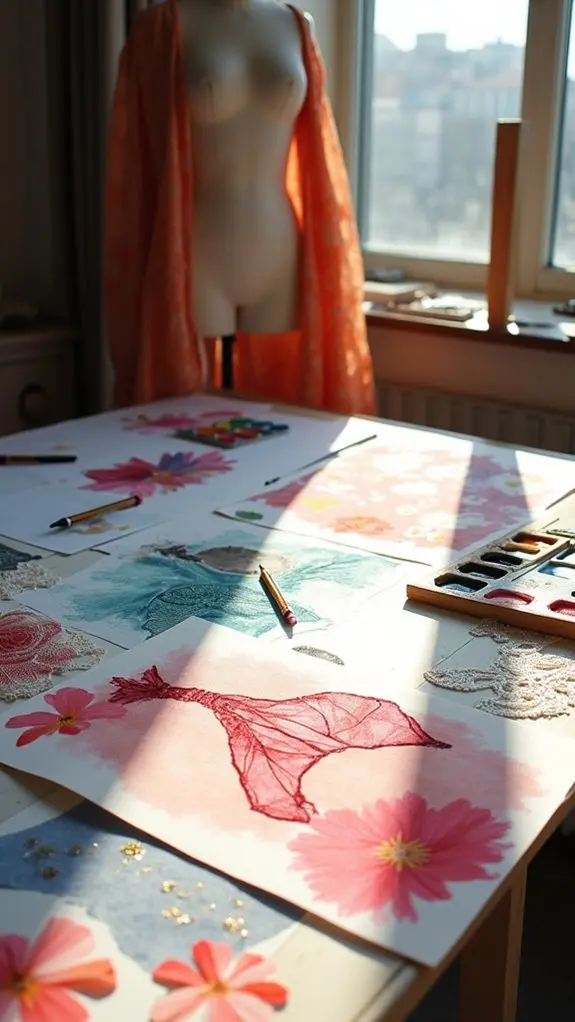
Fashion design sketches are a wild way to spot trends, whether you’re doodling a crazy new sleeve or figuring out which sneakers look coolest this year.
Drawing accessories, like wild earrings or hats with too much attitude, lets artists practice details and play with personality.
Mixing together paint, collage, and even scraps of fabric turns each page into its own mini runway—no sewing machine required!
Trend Analysis Through Sketches
While most people might think that staying on top of trends is all about scrolling through endless social media feeds, there’s actually a secret weapon in the fashion world: the sketchbook.
Designers use fashion sketches to do serious trend analysis, mixing old hits with what’s hot now to catch the next big wave. Instead of just flipping through magazines, they dive back into past collections and pop culture, all within their sketchbooks!
Adding mixed media—like scraps from magazines or splashes of digital art—makes these pages jump off the paper and sparks even bigger ideas. This process means even a pencil doodle can map out the future of fashion.
Here are three reasons it’s thrilling:
- You can spot trends before everyone else.
- It’s totally hands-on.
- Every sketch helps you level up!
Accessory Illustration Techniques
Plenty of sketchbook artists know that drawing clothes is cool, but accessories are where the real magic—and fun—happens. Bags, shoes, and jewelry might seem tiny, but they steal the show in fashion illustration, adding personality and flair.
To make accessories pop, artists dig into fashion magazines for inspiration and keep their eyes on details—like buckles, zippers, or wacky earring shapes. Using different drawing techniques, such as contour lines to outline shapes and shading to create the look of leather or shiny metal, really helps.
Adding bold colors with markers or subtle washes with watercolors can make a sketchbook page dance. To kick it up a notch, artists sketch accessories from wild angles or show them as part of a fun outfit scene.
Mixing Media for Style
After getting wild with accessories, it’s time to reveal the real power tools hiding in every artist’s kit: all those different art supplies just begging to be mixed together.
Fashion design isn’t just about drawing smooth lines—it thrives on mixing media for style! Watercolors, markers, colored pencils, and even gouache can give outfits a wow factor, layering texture and popping color into every sketch.
Want even more drama? Try collage techniques, like gluing down magazine cutouts or torn fabric swatches. Each page gets a shot of personality that’s impossible to ignore.
Take your fashion sketchbook to the next level with these heart-thumping ideas:
- Experiment boldly with collage techniques for wild, tactile surprises.
- Layer different paints and pencils—mixing media makes dreams real.
- Organize designs around bold color themes for a punchy, professional finish.
Study Human Anatomy
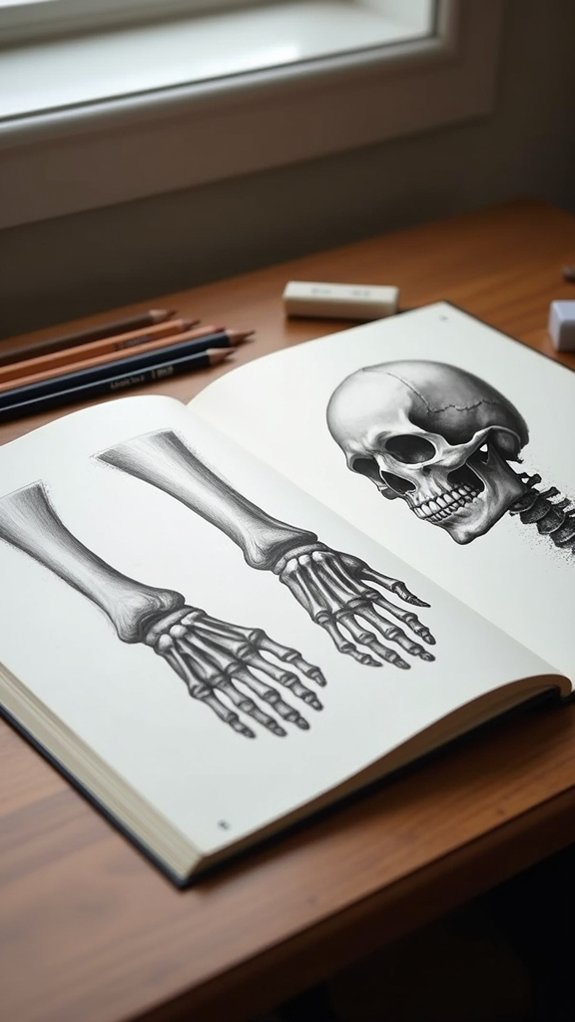
For anyone enthusiastic to level up their art, diving into human anatomy feels a bit like revealing secret superhero powers. Learning to study human anatomy isn’t just for future doctors—it’s almost magic for artists who dream of drawing realistic figures.
By breaking down the body into muscles, bones, and joints, artists get the “cheat codes” to make their sketches lively and accurate. Anatomy textbooks, videos, and even good old internet memes help artists spot details in faces and limbs they’d usually miss.
And nothing beats life drawing sessions, where sketching an actual, moving person makes everything twice as real and twice as exciting. Try using colored pencils to highlight muscles or bones—labeling them can make even the toughest anatomy facts stick for good.
Make a Self-Portrait
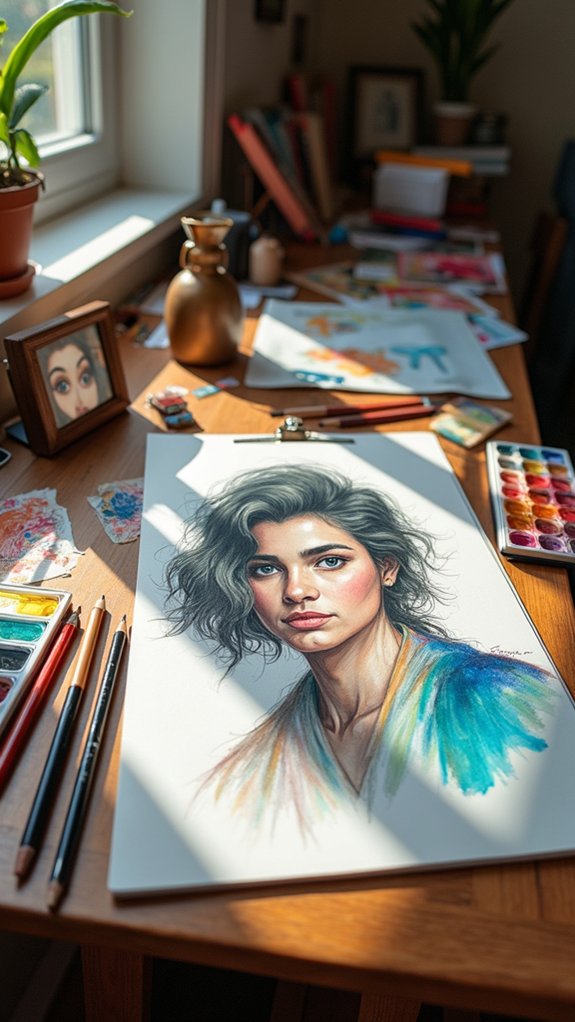
Making a self-portrait isn’t just a boring mugshot—try flipping your sketchbook, sketching from a funky angle, or letting your hair stick out in wild directions.
Grab every art supply you’ve got, from colored pencils to bold markers, and mix them for extra personality.
You can even capture your mood by changing up your style: moody and mysterious one day, goofy and grinning the next—it’s all up to you.
Explore Unique Perspectives
Ever wonder what it would be like to see yourself through someone else’s eyes—or maybe even through your own, but in a totally new way? That’s where making a self-portrait comes in!
When people immerse themselves in this sketchbook challenge, it goes way beyond looks; it’s a chance for personal expression and improving drawing skills all at once. Imagine using bold colors to show confidence or soft lines to capture a gentle mood.
Here are a few emotional reasons to try:
- Rediscover what makes you, *you*—quirky smiles and all.
- Reflect on your journey, and realize how much you’ve grown.
- Celebrate your interests by surrounding your portrait with meaningful objects.
Every sketch, no matter how wacky or serious, matters in your artistic story.
Mix Media Techniques
Although pencils and erasers are classic, things get way more exciting when an artist swaps in a wild mix of materials. Mix media is all about combining watercolors, ink, acrylic paint, and more to create a self-portrait that feels true to you, messy hair day and all. By layering drawing techniques—maybe loose sketches underneath bold paint splatters—an artwork comes to life, showing off energy and flair. Toss in scraps of fabric or magazine clippings for extra texture, and suddenly your page has more drama than a soap opera.
Here’s a quick cheat sheet for making your mixed media self-portrait pop:
| Material/Technique | Possible Effect |
|---|---|
| Watercolor washes | Soft backgrounds |
| Ink outlines | Sharp definition |
| Acrylic paint | Bold texture |
| Fabric/magazine scraps | Real-life dimension |
| Imperfect marks | Personal, spontaneous energy |
Capture Changing Moods
How does a face show every twisty feeling inside? With self-portraits, people can capture the roller coaster of emotions that life throws their way. Each drawing becomes a snapshot of a feeling—joy, sadness, even wild anxiety.
They might use exploding yellows for happy days, stormy blues for tough times, or even slap on mixed media touches, like scribbling powerful words across the page.
Think about drawing yourself in a different style or setting every time, matching the mood to a background—maybe a sunny park for excitement or a shadowy room for worry.
Here’s how to engage:
- Let colors and textures reflect your current emotion.
- Play with abstract shapes or exaggerated features.
- Add mixed media—words, collage, or textured paint.
Your face, your story—let it show!
Draw Your Favorite Sculptures
A handful of truly incredible sculptures have been turning heads for centuries, so why not let them inspire your sketchbook?
Drawing sculptures isn’t just about copying shapes—it’s a fantastic way to practice shading, experiment with form, and sharpen artistic techniques. Iconic sculptures from the Renaissance Period, like Michelangelo’s David or the Venus de Milo, are perfect starting points.
Try sketching these masterpieces from different angles, challenging yourself to capture their depth and detail. Don’t be afraid to scribble notes and thoughts right alongside your sketches.
Maybe you discover a cool shading trick or new way to show muscle definition—write it down! Let these sculptures spark your creativity, then mix their artistic magic with your own twist. Who knows what you’ll discover?
Participate in an Art Challenge
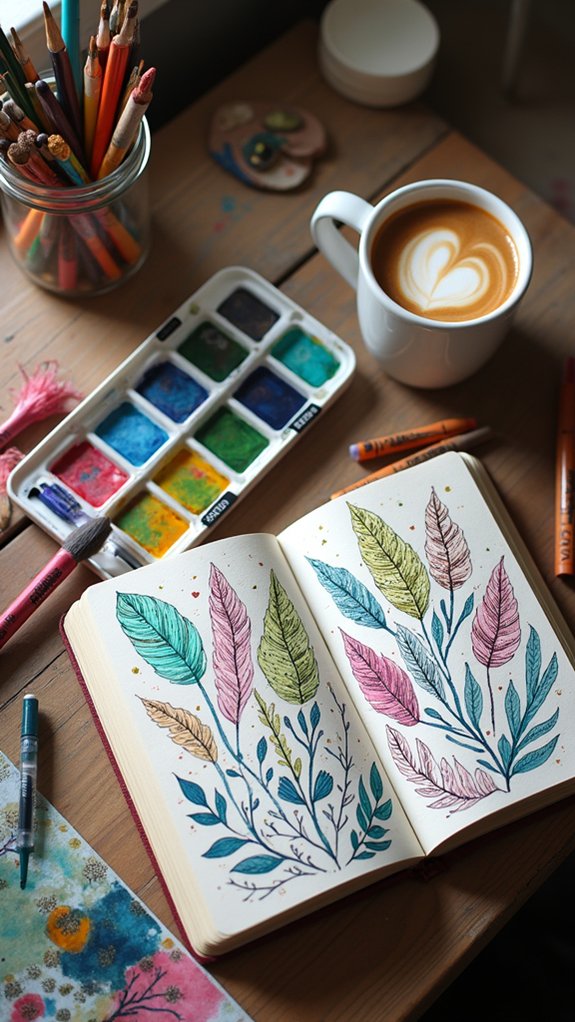
There’s nothing like an art challenge to kick your creativity into high gear! When your sketchbook pages feel empty and your ideas run dry, art challenges are a game-changer. They give you prompts and push you to try new themes or techniques, sometimes even mediums you’ve never touched before.
Plus, participating in something like Inktober or Mermay just feels exciting—you join a community and create alongside artists all over the world. The best part? You can actually see your growth as you fill your sketchbook with every new prompt.
Here are three reasons art challenges are a must-try:
- They spark creativity when you’re stuck.
- They build your art habits and skills daily.
- They connect you with a supportive, inspiring community.
Recreate Artworks by Other Artists
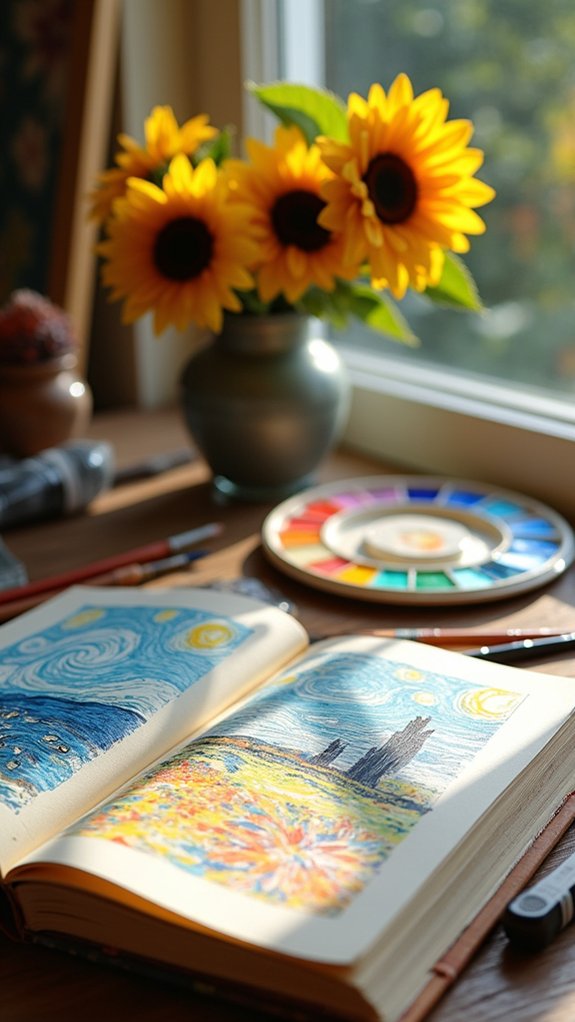
Copying artworks by other artists is like getting a backstage pass to their creative secrets—you see how they build shapes, layer colors, and add details.
It’s also a chance to play with new styles that might be totally different from your own, maybe wild and messy or super precise, just to see what fits.
As you flip through older pages and spot the improvements, it can be both hilarious and inspiring to notice how much your skills—and your personality—shine through in each sketch.
Analyze Artistic Techniques
Dive headfirst into the world of your favorite artists by recreating their masterpieces—it’s kind of like stepping into their creative shoes for a bit, minus the fancy hat or paint-splattered pants.
Analyzing their techniques helps break down the magic. How do they use color? Why does their brushwork feel so alive? By replicating artworks, anyone can get a front-row seat to the secrets hiding in plain sight.
Try taping a tiny printout of the original next to your own sketch for an instant side-by-side comparison. That feeling of discovery never gets old.
- Discover the hidden layers in your favorite masterpieces and let your sketchbook become a playground for new skills.
- Grow your confidence by understanding genius techniques bit by bit.
- Feel the thrill of unraveling artistic mysteries yourself!
Experiment With Different Styles
After poking around in the brains of famous artists and picking up neat tricks, it’s time for something wildly fun—swapping styles and recreating artworks by other artists, like a game of artistic dress-up.
This isn’t just copying; it’s detective work. By recreating artworks in your sketchbook, you get to zoom in on their artistic choices. Why did they pick those wild colors? How did they make their brushwork look that cool?
You can even add mini printouts of the originals right beside your own version, then scribble notes about what you love or what you’d change. Experiment with mixed media, pencil, or wild markers!
Share your masterpieces with other artists, gather feedback, and fill your sketchbook with a whirlwind of inspiration and technique.
Reflect on Creative Growth
Although it might sound a little sneaky at first, stepping into the shoes of another artist and recreating their artwork is actually a secret passage to creative growth. When a page in your sketchbook feels empty, or you’re stuck after trying the wild ideas from the previous post, recreating works by artists you admire lets you get Better at Drawing in ways textbooks just can’t teach!
Each study sharpens your eyes and hands, helping you spot secrets behind colors, brushwork, or form. Fun tip: print out mini versions of the originals to tape alongside your sketch.
Here’s why this can feel amazing:
- Discover new techniques hiding in plain sight.
- See your progress grow—like magic!
- Understand the artist’s story, and maybe find your own.
Doodle Everyday Objects
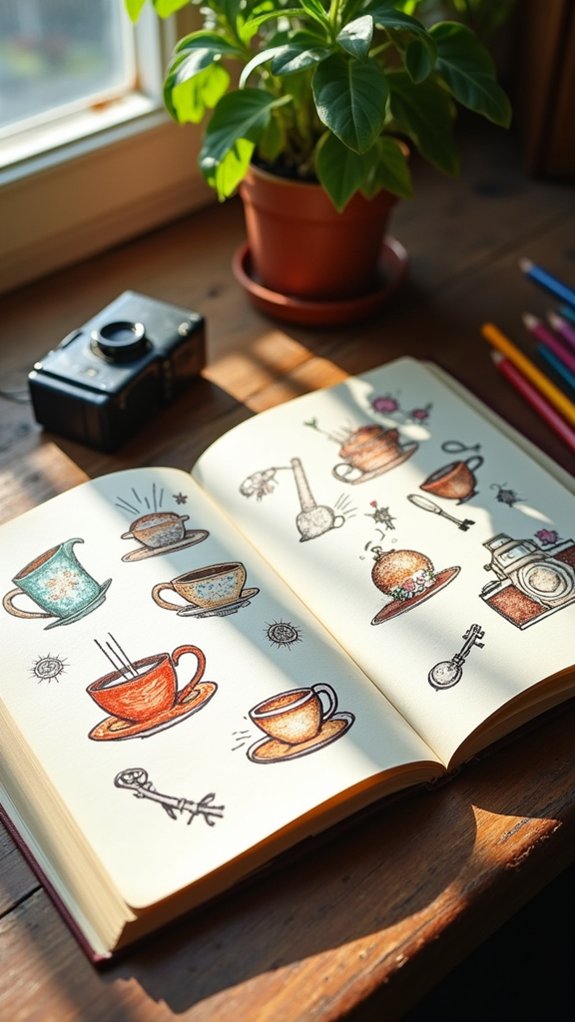
Every kitchen drawer, classroom desk, or bedroom shelf is packed with objects just waiting to be doodled.
Let’s explore the world of everyday stuff—spoons, notebooks, potted plants—and see what they can make you feel when you really look at them.
Doodling things you see every day can seriously sharpen your observing superpowers, helping you notice weird shapes or tiny textures you usually ignore.
Don’t stress about getting every detail perfect; there’s loads of creative freedom here.
Give a coffee mug a silly face, or turn a pair of scissors into something wild. Allowing humor and imagination into the mix can make your sketchbook way more fun.
Over time, doodling random objects builds up your confidence and creates a cool visual diary of your life.
Draw Within Your Comfort Zone
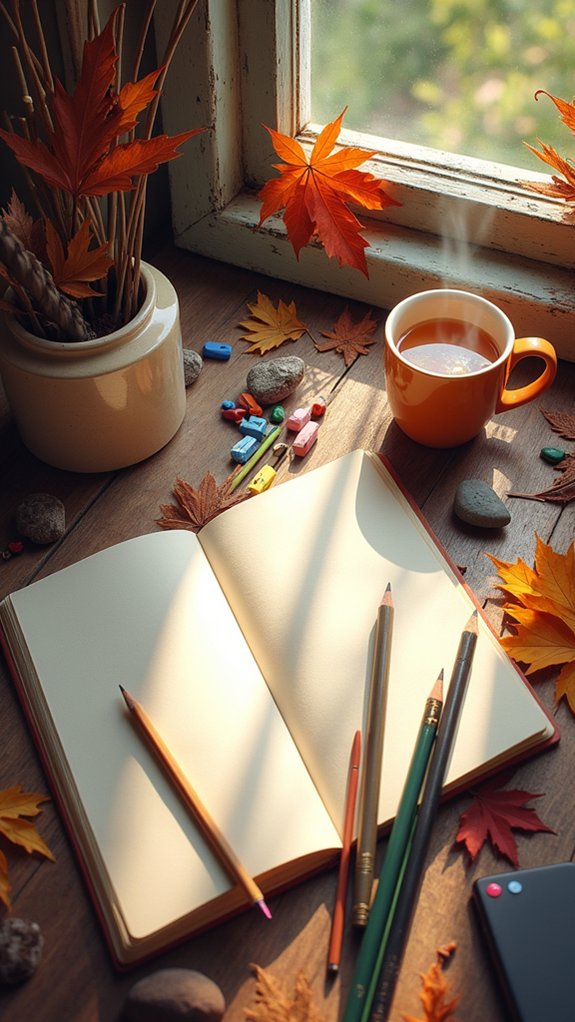
When it comes to filling up a sketchbook, sticking to familiar territory isn’t just a safe bet—it can actually make things way more exciting. Comfort zone exploration isn’t about being lazy or boring; it’s about diving deep into what you love and growing from there.
Focusing on familiar subjects, like cats you see every day or weird shoes from your closet, helps you build confidence while capturing what really interests you. It’s like leveling up in your own favorite game!
Here are three reasons to draw what you know and love:
- Watch your skills blast off as you revisit favorite themes and see your growth over time.
- Enjoy every second with personal interest subjects that spark real excitement.
- Feel inspired when your sketchbook becomes a vibrant story of you.
Try a New Drawing Medium

After spending some quality time sketching the things you already know and love, it’s time to shake things up a little.
Bored with pencils? Grab a stick of charcoal and start some charcoal experimentation—you might end up with a wild, moody masterpiece (and, yes, messy hands).
Or try out some pastel techniques; blending those soft colors can feel like finger painting for grown-ups, and the textures are surprisingly awesome.
Curious about technology? Digital tools open up a world of brushes, textures, and wild undo powers. No eraser dust required!
Playing with new materials helps you learn, make happy mistakes, and discover cool ways to express yourself.
Stuck in a rut? Give your art a boost by taking a chance on an unfamiliar medium.
Floral Clusters With Markers
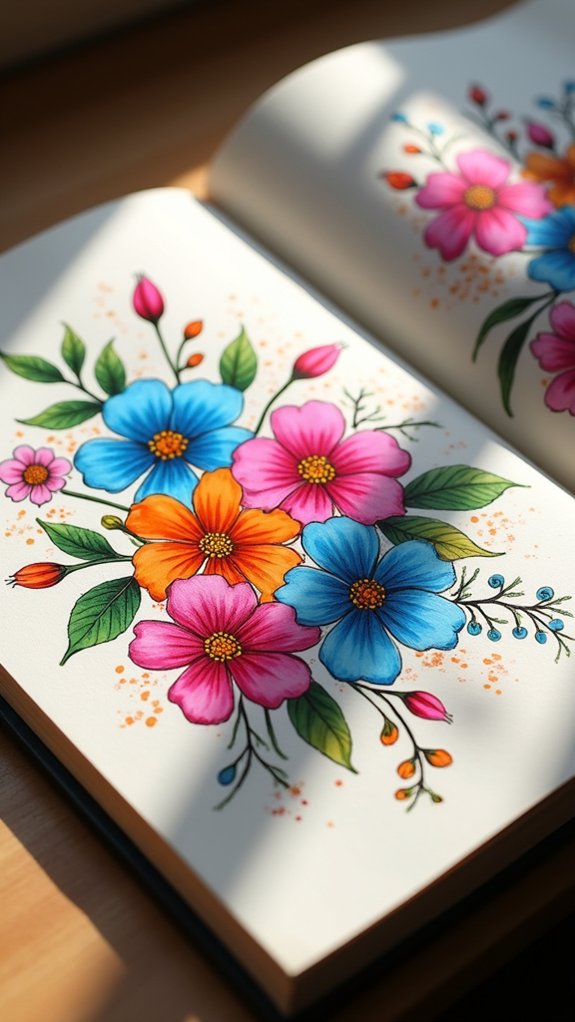
Layering light and dark markers seriously takes floral clusters to the next level, adding cool shadows and details that make flowers pop right off the page.
If there are any awkward white gaps messing with the vibe, just stick in some dots, dashes, or tiny leaves to make everything feel connected.
It’s almost like patching a flower garden together—where every little scribble adds to the magic.
Layering Light and Dark
Although flowers are everywhere, giving them a wild, playful twist in your sketchbook can make even a regular old bouquet look like a magical explosion.
Start by grabbing a light-colored marker and letting loose with bendy lines, sketching flower shapes that twist and turn. Fill the centers with wiggly spirals—each one adds depth perception that makes petals pop out like 3D cartoons.
Now, pick a darker marker. Layering textures here is key: trace veins and outlines for bold contrast. Soon, you’ll see the clusters coming alive on the page with contrasting colors adding instant drama.
Here’s how the magic hits:
- Layering textures: Feel the page transform under your marker.
- Contrasting colors: Watch flat flowers turn electric.
- Depth perception: Suddenly, your bouquet feels real!
Filling Gaps Creatively
When sketchbook pages start looking more like a scattered flower field than a design, creative gap-filling becomes the secret weapon.
Using floral doodling techniques kicks things off—just grab a light-colored marker, sketch bendy flower shapes, and don’t worry if they aren’t perfect. This is all about whimsical designs exploration, so add a wiggly spiral smack in the center of each bloom for extra flair.
Cluster your flowers around the page but leave some space for playful patterns like dots and dashes. Now, here’s where marker layering effects shine: pick a darker marker and go over petals or add tiny details wherever you want more depth.
Suddenly, what looked like a mess becomes a wild, joyful garden—chaos totally under control!
Draw Color Spirals

Spirals are one of those magical shapes that seem simple, but can turn into a wild, colorful adventure right on the page. To start, a lightest hue becomes the heart of your spiral, a tiny sun in the center. From there, small stick lines twist outward, and as each new layer fills in, the colors darken, making the spiral look deeper and livelier.
It’s like a rainbow tornado, but totally under your control. Color theory exploration becomes your superpower! Spiral design techniques change as you experiment, and you’ll find relaxation through art—it’s like your stress is spinning away.
Here’s why color spirals totally rule:
- They boost your mood with dazzling color blends.
- They turn mistakes into artful surprises.
- They teach awesome color skills—without feeling like homework!
Hand-Letter Inspiring Quotes
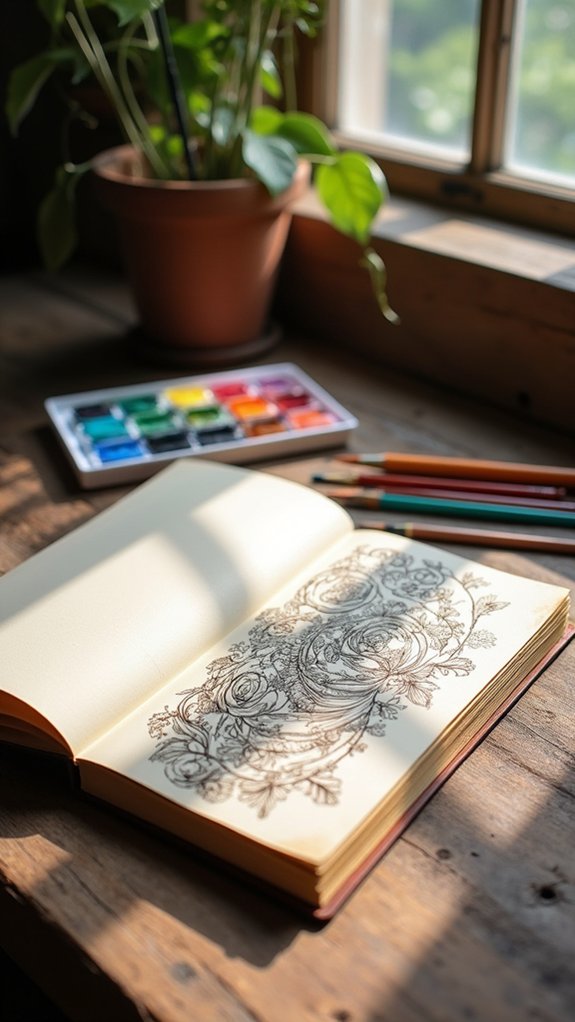
If someone is ever looking for a way to make their sketchbook both meaningful and eye-catching, hand-lettering inspiring quotes might just be the answer. Picture it: you grab your favorite markers, immerse yourself in inspirational lettering techniques, and start exploring unique fonts right on the page. It’s surprisingly calming and gives you a chance to play with color blending methods, too. Try switching up font sizes, doodling little flourishes, or using graph paper to keep everything straight—because, let’s be honest, wobbly letters are only funny for so long. Practicing this regularly boosts your skills and confidence, and who knows, maybe your motivational quote will become the next big trend at school! Here are some ways to get started:
| Technique | Tools/Mediums |
|---|---|
| Unique font exploration | Markers, pencils |
| Inspirational blends | Watercolor, gel pens |
| Consistent spacing/align. | Graph paper, templates |
Illustrate a Song or Book Scene
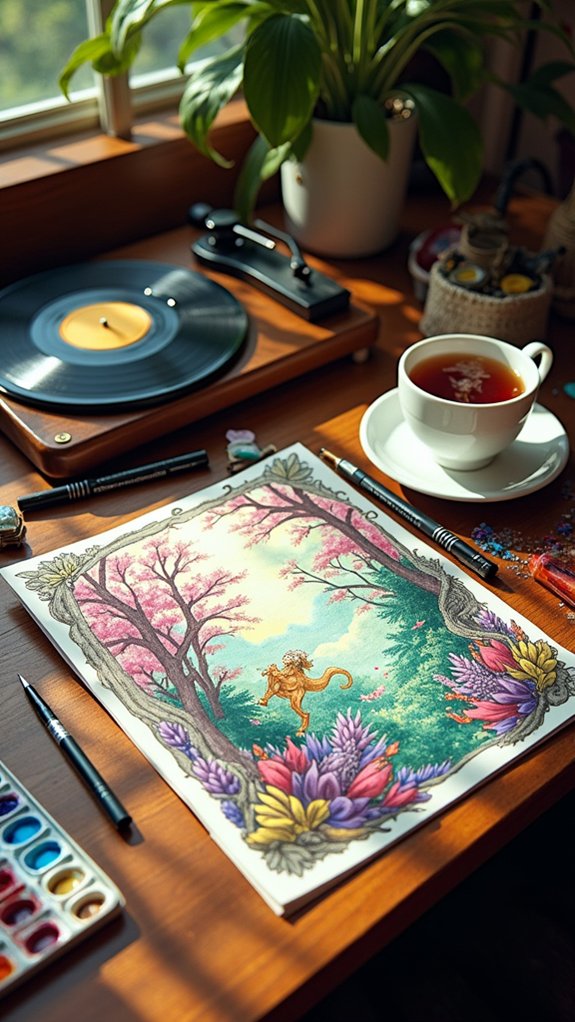
Even the most ordinary sketchbook can start to feel like a portal to another world once someone decides to illustrate a favorite song or book scene.
Suddenly, the pages turn into a stage where emotions and stories come alive! By using song interpretation techniques and scene visualization strategies, artists can dive deep into their imaginations, making every line and color choice meaningful.
It’s more than just doodling—it’s about expressing the heart of a song or book using your own artistic expression methods.
Here’s how to turn those feelings into something you can see:
- Pick a scene that grabs your heart—note the mood, characters, and setting.
- Experiment with art styles and materials—make it yours!
- Add meaningful text for extra magic and connection.
Frequently Asked Questions
What to Fill up a Sketchbook With?
In response to the question, individuals often choose to fill their sketchbooks with inspirational quotes, creative doodle prompts, and original character designs, providing both artistic practice and motivational content while documenting their growth and evolving style.
How Do I Fill an Empty Sketchbook?
When considering how to fill an empty sketchbook, one might use sketchbook prompts, engage in creative exercises, and participate in art challenges. These approaches encourage experimentation, providing structure and inspiration to transform blank pages into expressive works.
How to Fill Empty Space in Sketchbook?
Filling empty space in a sketchbook becomes easier by exploring creative prompts, utilizing various doodle techniques, or developing consistent sketchbook themes. This approach encourages experimentation, leading to visually engaging pages and fostering continuous artistic growth.
What to Draw 100 Ideas?
Seeking 100 ideas of what to draw, one might consider character designs, explore nature studies by sketching plants or animals, and experiment with abstract patterns, alongside urban environments, imaginative creatures, daily objects, portraits, and scenes from memory.
Conclusion
Getting stuck with a blank sketchbook can feel super annoying, but it doesn’t have to be the end of your creativity. Try new shapes, doodle what you see, scribble quotes, or mash up colors until something surprises you. Every page is a chance to experiment, mess up, laugh, and try again. With all these ideas, you’ll fill your sketchbook with cool stuff—and who knows, maybe even discover something totally unexpected about your own style!

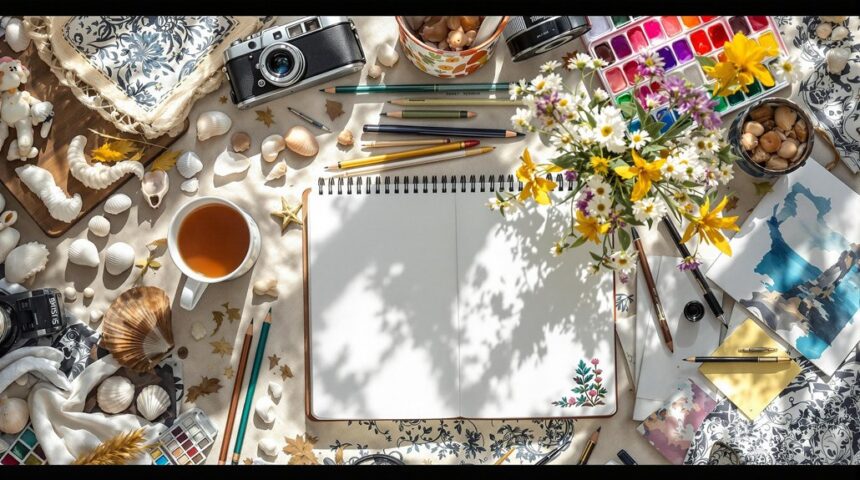
Leave a Reply